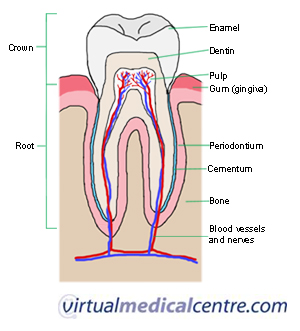The mouth is the first organ in the digestive tract. The foods are going to enter into the mouth in the ingestion process.
The salivary glands, inside the mouth, produce saliva that moistens the food and makes it easier to chew. The salivary enzyme is amylase that breaks down complex starch molecules into simpler sugar molecules (chemical digestion).The mouth also plays an important role in mechanical digestion. The teeth help to digest food mechanically by breaking it into smaller pieces.
There are different teeth types with different shapes and functions:
Incisors: These are your front teeth and are used for biting into your food. They are chisel or wedge-shaped. A human adult has 4 incisors in each jaw
Canines: These are pointed and are used for tearing. An adult human has 2 canines in each jaw.
Premolars and molars at the back of the mouth are larger and broader. They grind food into smaller pieces as you chew. An adult human has 4 pre-molars and 6 molars in each jaw. Third molars are often called wisdom teeth; (they developed thousands of years ago when human diets consisted of mostly raw and unprocessed foods that required the extra chewing and grinding power of a third set of molars. Today wisdom teeth are not needed for chewing and, because they can crowd other teeth, are often removed).
A human baby has 20 baby or milk teeth. These start to develop at about 6 months old and last until you are about 5 - 6 years old. A human adult has 32 teeth called permanent teeth. These start to grow when you are about 5 -6 years old. They replace your milk teeth.
Each tooth consists of a crown and one or more roots.
The crown is the functional part that is visible above the gum. The root is the unseen portion that supports and fastens the tooth in the jawbone. The clear outer layer of the crown is the Enamel, the hardest substance in the human body. The outer layer of the roor is cementum, a bonelike substance that anchors the tooth to the jawbone. Directly beneath the outer layer is dentin, a hard, mineral material that is similar to human bone, only stronger. Dentin surrounds and protects the pulp, or core of the tooth. Pulp contains blood vessels, which carry oxygen and nutrients to the tooth, and nerves, which transmit pain and temperature sensations to the brain.
The muscular tongue helps mix the food with saliva and the enzymes it contains.
When you swallow, the lump of chewed food, now called a bolus, passes into the pharynx.
The pharynx serves both the respiratory system and the digestive system. It connects the mouth to the rest of the digestive tract and, also connects the mouth and nose to the rest of the respiratory system. To prevent food or liquid from entering the trachea (windpipe), the epiglottis (a small flap of tissue) closes over the opening of the larynx (voice box) during swalowing (deglutition).
The salivary glands, inside the mouth, produce saliva that moistens the food and makes it easier to chew. The salivary enzyme is amylase that breaks down complex starch molecules into simpler sugar molecules (chemical digestion).The mouth also plays an important role in mechanical digestion. The teeth help to digest food mechanically by breaking it into smaller pieces.
There are different teeth types with different shapes and functions:

Incisors: These are your front teeth and are used for biting into your food. They are chisel or wedge-shaped. A human adult has 4 incisors in each jaw
Canines: These are pointed and are used for tearing. An adult human has 2 canines in each jaw.
Premolars and molars at the back of the mouth are larger and broader. They grind food into smaller pieces as you chew. An adult human has 4 pre-molars and 6 molars in each jaw. Third molars are often called wisdom teeth; (they developed thousands of years ago when human diets consisted of mostly raw and unprocessed foods that required the extra chewing and grinding power of a third set of molars. Today wisdom teeth are not needed for chewing and, because they can crowd other teeth, are often removed).
A human baby has 20 baby or milk teeth. These start to develop at about 6 months old and last until you are about 5 - 6 years old. A human adult has 32 teeth called permanent teeth. These start to grow when you are about 5 -6 years old. They replace your milk teeth.
Each tooth consists of a crown and one or more roots.

The crown is the functional part that is visible above the gum. The root is the unseen portion that supports and fastens the tooth in the jawbone. The clear outer layer of the crown is the Enamel, the hardest substance in the human body. The outer layer of the roor is cementum, a bonelike substance that anchors the tooth to the jawbone. Directly beneath the outer layer is dentin, a hard, mineral material that is similar to human bone, only stronger. Dentin surrounds and protects the pulp, or core of the tooth. Pulp contains blood vessels, which carry oxygen and nutrients to the tooth, and nerves, which transmit pain and temperature sensations to the brain.
The muscular tongue helps mix the food with saliva and the enzymes it contains.

When you swallow, the lump of chewed food, now called a bolus, passes into the pharynx.
The pharynx serves both the respiratory system and the digestive system. It connects the mouth to the rest of the digestive tract and, also connects the mouth and nose to the rest of the respiratory system. To prevent food or liquid from entering the trachea (windpipe), the epiglottis (a small flap of tissue) closes over the opening of the larynx (voice box) during swalowing (deglutition).

No hay comentarios:
Publicar un comentario